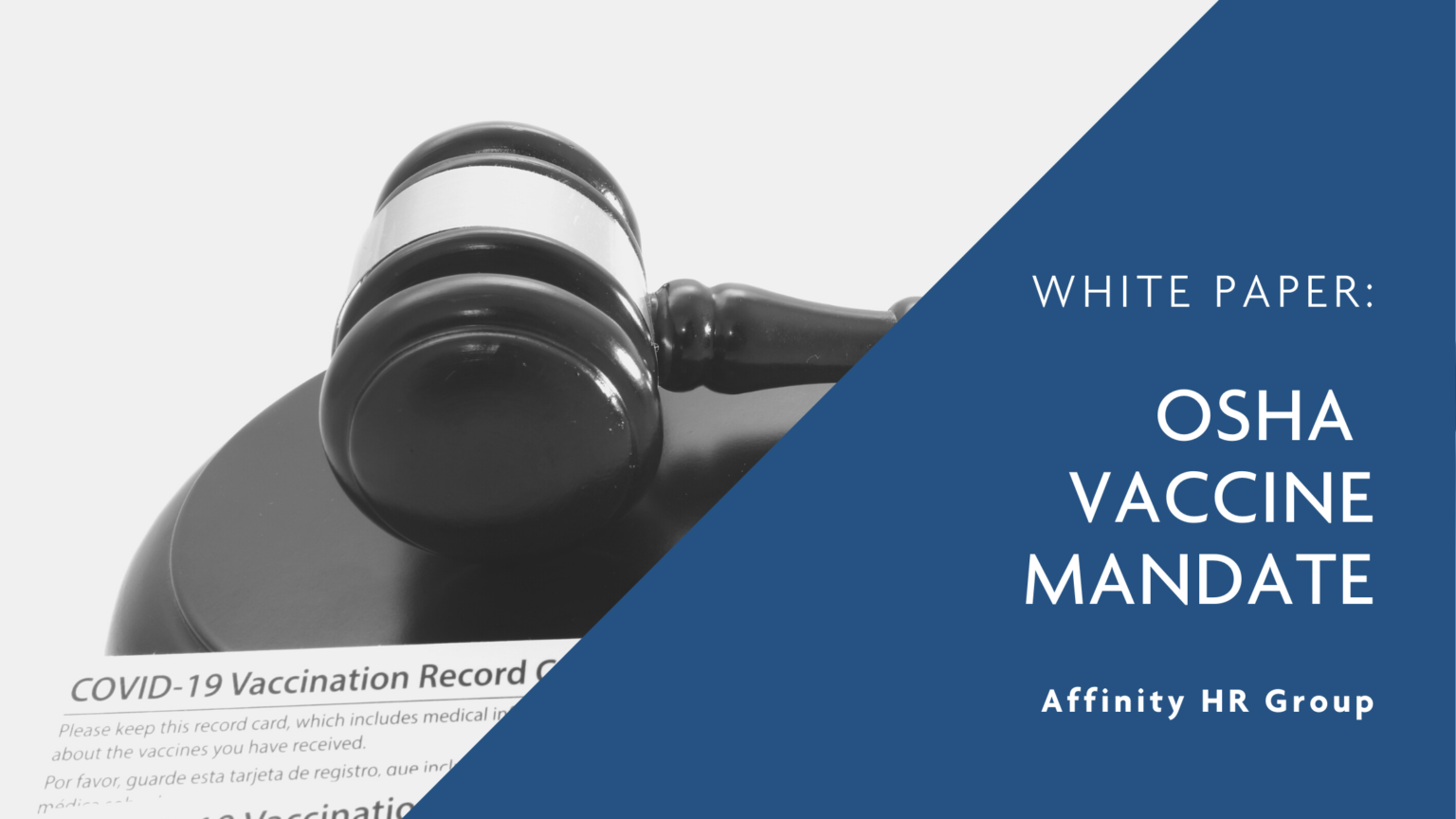Notice
On November 6, 2021, the 5th US Court of Appeals issued an injunction based on a legal challenge filed in its courts. On November 12, 2021, the 5th Circuit ruled that this injunction applies country-wide and has ordered OSHA to “take no steps to implement or enforce…until further court order.” Therefore, OSHA has currently suspended such activities while this and several other legal challenges work their way through the various court systems. If this or any other court confirms or overturns the ETS, no one should consider it the final say until a decision is ultimately issued by the US Supreme Court.
Even with this latest development, Affinity HR Group still recommends that you start preparing for how your company will implement and enforce this ETS if it proceeds as released or in some variation. However, we do not recommend expending too much time or expense until the US Supreme Court has ruled.
Background
The Occupational Safety and Health Administration (OSHA) was created “to ensure safe and healthful working conditions for workers by setting and enforcing standards and by providing training, outreach, education, and assistance.” Pres. Biden’s administration believes that protecting workers from COVID-19 falls under this definition, thereby giving OSHA the power to implement any rule with the purpose of protecting employees.
On November 5, 2021, OSHA published an emergency temporary standard establishing the requirement to “minimize the risk of COVID-19 transmission in the workplace” and to “protect unvaccinated employees of large employers from the risk of contracting COVID-19 in the workplace.” It became effective upon its publication and will be in effect for six months but may become a permanent rule if needed.
The ETS mirrors the expectations outlined by Pres. Biden in September when he announced the “Path Out of the Pandemic” in September 2021. Analysis of the vaccine mandate indicates that it will lead to the vaccination of 23 million people, preventing over 6,500 deaths and over 250,000 hospitalizations.
OSHA also issued requirements that, in states that have their own OSHA entities, state plans must be developed that meet these standards at a minimum. If they do not, OSHA may implement these requirements in those states as well.
Many of the legal challenges argue that COVID-19 is not a workplace-specific danger so OSHA does not have the authority to implement this mandate. Other challenges argue that OSHA does not have the right to impose requirements that are prohibited under the laws of certain states.
Covered employers and employees
This ETS applies to all private employers with 100 or more employees in the US except federal contractors and subcontractors or healthcare employees as they are subject to different, stricter rules. To count employees, private employers must include all employees in the US even if they are in multiple locations or states. They must also count all employees regardless of their classification or schedule, including full-time, part-time, temporary, and seasonal employees; minors must also be counted, even though they may need parental consent to be vaccinated. Independent contractors and employees placed through a staffing agency do not count toward this total.
While the ETS is in effect, an employer is covered if they have 100 employees on or after November 5, 2021. Once an employer is covered, they remain covered until the standard expires even if they fall below the 100-employee threshold.
If an employer has 100 or more employees, this ETS applies to all of their employees except those who do not report to a workplace where other individuals (i.e., co-workers or customers) are present; work from home; or work exclusively outdoors. Even if there are employees who meet the criteria to be exempt from the vaccine mandate, they must be counted toward the total employee number.
OSHA focused this ETA on large employers with the expectation that they have better capacity to administer requirements that may prove difficult or prohibitive for smaller employers. However, OSHA is studying options that could be applied to smaller employers without causing too much disruption so this may be coming in the future.
What is required
This ETS includes multiple standards not just about vaccines but also about testing, masking, reporting and record-keeping. All of these standards are effective December 5, 2021, except the testing requirement which is effective January 4, 2022.
By December 4, 2021:
Develop and implement compliant policy: Whether you decide to implement a vaccine-only requirement or a vaccine policy with a testing and face covering option, you must develop a policy that meets OSHA’s standards. While employers can draft a customized policy, OSHA has provided a template of each version which includes everything needed to be compliant and which the employer can customize with their company information and state laws. The OSHA template can be found here: OSHA – Mandatory Vaccine Policy and OSHA – Vaccine, Testing, and Face Coverings Policy. The policy should be retroactive to November 5, 2021 or as soon as you become a covered employer.
Tracking: Employers must develop and implement a method for tracking employees who are fully vaccinated, partially vaccinated, or unvaccinated. If they are unvaccinated, they must also note if it is due to medical accommodation, religious accommodation, or neither. Employers must also require and retain copies of proof of vaccination. The tracking and records must be kept confidential as with all medical information.
Vaccine requirements: Employers must draft and implement policies requiring all employees to receive a COVID-19 vaccine that is approved by the FDA (currently Pfizer, Moderna, or Johnson & Johnson), WHO, or given as part of a clinical study and to provide official documentation of their vaccine status. Since the vaccine is free to everyone, employers do not need to pay for the vaccine. Employers must allow exceptions for certain medical or religious reasons (see below). Employers also have the option to offer a testing alternative (see below).
Paid time off to receive vaccine: Employers must draft and implement policies granting employees up to four hours of paid time off to receive each dose of the COVID-19 vaccine during working hours. Employers do not need to pay for any additional costs such as transportation costs or travel time. This must be paid at the employee’s regular rate of pay and cannot be deducted from any paid time off the employee may have available to use. While the employer cannot dictate when the employee takes off to get vaccinated, if an employee chooses to get vaccinated outside of work hours, the employer does not need to provide pay for this time off.
Time off to recover from side effects of the vaccine: Employers must draft and implement policies granting employees reasonable paid time off to recover from any side effects of receiving the vaccine. The employer may require employees to use any paid time off available to them for the purposes of sick time; however, they cannot require employees to use any time off not intended for sick time such as that time off designated as “vacation” or “personal.” The employee cannot require the employee to borrow time off that will be available in the future.
This time off must be “reasonable” which according to the CDC could be one, two or “a few” days. OSHA presumes making two days available for recovery per dose will be sufficient. However, employers may want to extend this by a couple of days as a reasonable accommodation.
Reasonable accommodation: Employers must allow reasonable accommodations for those with documentable medical and/or religious reasons preventing them from getting vaccinated. The accommodations could include a leave of absence, working from home, or simply following the policies for unvaccinated employees, whatever can be provided in accordance with the documentation and without undue hardship on the company.
Employers should have a consistent policy and procedure for processing accommodation requests. This should include a dialogue between employer and employee, documentation requirements, a limited number of people who can make the determination, and confidentiality of all information received. (Most managers and supervisors only need to know the accommodation, not the reasons why the employee needs it.)
Employers must make a good-faith effort to implement the vaccine mandate which means they cannot accept any and all requests for reasonable accommodation without following a legitimate procedure to ensure it is warranted. Not only would this violate the ETS but it would create a difficult precedent for the employer to meet when an employee requests an accommodation for another reason.
You can find more guidance on reasonable accommodations here or on the EEOC website.
Face coverings: Employers must require all unvaccinated and partially-vaccinated employees to wear approved face coverings while indoors or in a vehicle with another person due to work. Employers must allow any employee to wear a face covering if they choose to, regardless of vaccination status. Employees must also be allowed to wear an approved respirator instead of a face covering if they choose too. Employers are not required to pay for face coverings or respirators for employees who need to or choose to wear them unless required under a current agreement such as a collective bargaining agreement.
Notification of positive test result: Employers must draft and implement policies requiring any employee (unvaccinated or vaccinated) to “promptly” report their positive result or diagnosis of COVID-19 to the company. Those employers must also implement procedures to immediately remove a COVID-19-positive employee from the workplace, again regardless of vaccination status. These employees must be kept out of the workplace until they meet the criteria for returning to work as currently defined by the CDC and/or state authorities.
Once an employee tests positive for COVID-19, employers must also inform other employees with whom the positive employee may have been in close contact within the 14 days prior to diagnosis. Again, following CDC and state guidelines, employers must take action appropriate upon notification from the health department or the employee’s health care provider based on if the employee is vaccinated or unvaccinated.
If an employee tests positive using an antigen test but has no symptoms, they may take a Nucleic Acid Amplification Test (NAAT) test. If that result is negative, they may return to work. However, if they test positive on a NAAT test they must follow the isolation protocols regardless of whether or not they display symptoms.
Employee confidentiality must be maintained throughout the process.
Inform employees: Employers must provide the following information to all employees in clear language and at a literacy level that they can understand using the normal methods of distribution:
- information about the ETS and the resulting workplace policies and procedures
- the CDC’s “Key Things to Know About COVID-19 Vaccines”
- information about protections against discrimination, harassment, and retaliation; and
- information about laws which include criminal penalties for knowingly supplying false statements or documentation.
While it is not required to have the employee sign off on receipt of this information, it may be helpful to enforce policies and show efforts to comply.
Record-keeping: Employers must maintain records regarding vaccine status, documentation, and test results. These can be kept in paper or electronic format as long as the proper access restrictions are put in place given the medical information involved.
OSHA reporting: Employers must report any work-related COVID-19 fatalities to OSHA within 8 hours and hospitalizations within 24 hours upon learning of them. In addition, employers must provide aggregate information of employee vaccination status and testing history to OSHA within 4 hours of a request being received. However, employers do not need to submit any policies or procedures to OSHA unless requested.
Access to records: An employee and their authorized representative must have access to these records kept on that employee. The employer must also provide to an employee or an authorized representative of the employee the total number of employees and the aggregate number of fully-vaccinated employees at the workplace, without providing information about specific employees.
By January 4, 2022:
Testing option: Covered employers may, but are not required to, create a “testing option” allowing unvaccinated or partially-vaccinated employees to submit negative test results for COVID-19 once per week along with wearing approved face coverings in the workplace. These results must be obtained using a diagnostic or antigen test that tests for SARS-CoV-2 and is cleared, approved, or authorized by the FDA; administered in accordance with the instructions; and is not both self-administered and self-read unless observed by the employer or a telehealth provider.
The testing option would apply to all employees who remain unvaccinated whether by choice or due to medical or religious reasons but would not be required in the 90 days after an employee tested positive for and recovered from COVID-19. Employees who are away from the workplace for more than 7 days must submit a negative test result within 7 days prior to returning to the workplace. Employers are not required to pay for the time off needed to take these tests.
The ETS states that employers are not required to pay for these COVID-19 tests. However, this is one area where state law will supersede the ETS. In states that have laws prohibiting actions such as charging employees for medical exams, requiring expense reimbursement, or classifying test expenses as a wage deduction therefore dropping the employee below minimum wage, employers will have to bear some if not all of the cost. Employers may also be required to pay for testing if their employees currently work under an agreement such as a collective bargaining agreement which has this as a condition.
If an employer decides to offer testing to its employees, they are able to utilize a pooling testing method which may expedite the process and save money. As long as the testing protocols follow CDC and OSHA guidelines, employers have several options to offer depending on what works best for them and their employees within state law.
Non-retaliation
Employers cannot take or allow any manager, co-worker, or third party to take adverse action against or to harass any employee including those who take advantage of any portion of these mandates, who are or are not vaccinated, who cannot get vaccinated due to a legitimate reason, or who choose to wear a mask regardless of vaccination status. This includes overt actions or disparate impact that may be the result of certain policies or procedures.
Penalties
While no penalties were specified in the ETS, standard penalties for employers who fail to meet OSHA standards range from $13,653 to $136,532 depending on factors such as number, seriousness, or willfulness of the violations. Some experts believe fines around $2,000 for first and minor offenses is possible. However, Congress is in the process of introducing legislation to increase the range of possible OSHA fines to $70,000 up to $700,000 for repeated violations. If this ETS becomes a permanent rule as planned, these higher fines would apply if passed.
Employee resistance
Given the recent employment trends, it is expected that some employees will resign rather than get vaccinated or submit to weekly testing. According to some recent small polls:
- A recent survey of 1,519 unvaccinated, employed (but not self-employed) people conducted by The Kaiser Family Foundation indicated that 37% of the workforce threatened to resign if required to get vaccinated but allowed to test; 72% would quit if no testing option was required. The same poll showed that so far 5% of unvaccinated have left their jobs due to vaccine requirements.
- An earlier study done by Qualtrics indicated that 44% of employees would leave their jobs if required to get vaccinated but also showed that 38% would leave if no vaccine requirement was implemented at their employer.
However, since an estimated 84 million employees are expected to be impacted by this mandate, some think that many employees will realize they are going to have to comply whether at their current or next company, and ultimately may choose not to give up their earned seniority and benefits to start over. Also, in all states but Iowa, most employees who resign to protest the vaccine requirement will not be eligible for unemployment benefits.
Now that Pfizer has full FDA approval (with the other two in process of getting it) and employees can now get paid time off to get vaccinated and approved time to recover from any side effects, there is hope that many will take this opportunity to get vaccinated and stay healthier in the long run.
As for impacts on small companies that do not fall under this ETS, some believe that this ETS will give smaller companies the freedom to implement their own vaccine requirements, thereby covering even more of the US workforce. Recent court rulings upholding an employer’s right to make vaccination a requirement of an employment-at-will workplace bolsters this option for employers who want to require vaccinations and are located in states that have not prohibited such requirements.
Employee education
One way to help ease an employee’s vaccine hesitancy or resistance is to provide them with information about the benefits of getting vaccinated against COVID-19. You can refer them to some unbiased resources such as the CDC, UCLA and Nebraska Medicine.
Other points to consider include:
- While it is possible for vaccinated people to get COVID-19, studies show that, as compared to unvaccinated people, vaccinated people are five times less likely to become infected with COVID-19 and 30 times less likely to be hospitalized.
- As a result of unvaccinated people accounting for 97% of the COVID-19 hospitalizations resulting in the cost of $5.7 billion to the healthcare system in July and August of 2021 alone, unvaccinated people may be required to pay higher insurance rates, similar to how smokers currently do.
- While insurers were waiving most of the costs of hospital care due to COVID-19 a year ago, 70% of the largest insurers are not waiving these costs, putting the burden of the average $20,000 per hospitalization on the patient, especially if unvaccinated since COVID-19 is now deemed as “preventable.”
- Per the CDC, vaccinated people have shorter quarantine requirements if exposed to someone who tests positive for or has symptoms of COVID-19. While unvaccinated people must immediately self-quarantine for up to 14 days, vaccinated people do not need to self-quarantine unless they exhibit symptoms.
- Vaccinated people are not required to wear face coverings in as many situations as unvaccinated people.
- Vaccinations are now required for many travel destinations and most modes of public transportation.
Action for you to take
- By December 5, 2021:
-
- Survey all employees by asking two yes/no questions: “Are you vaccinated? Do you plan to be vaccinated?”. [This is not protected information under HIPAA so it is fine to ask and record.] Do not ask for or allow employees to provide more information unless they are submitting a request for a reasonable accommodation.
- Create a confidential method to track vaccination status for all of your employees. Include policies for repercussions if an employee submits falsified documentation.
- Develop, implement, and enforce vaccine and face covering policies.
- Designate which employees will fall under the vaccine mandate and those that meet the exceptions.
- Develop and implement procedures for handling reasonable accommodation requests as well as the requirements these employees will be held to.
- Establish policies for paying employees to get vaccinated and, if necessary, taking time off to recover from side effects.
- Develop, implement, and enforce procedures requiring employees to report a positive result, removing a positive or exposed employee (regardless of vaccination status) from the workplace, and timing for their return-to-work.
- Begin reporting all work-related COVID-19 fatalities to OSHA within 8 hours and hospitalizations within 24 hours.
- Provide employees with the required information.
- Develop confidential record-keeping procedures for vaccines, testing, and positive results.
- Be prepared to provide information as requested by an employee, a representative, OSHA, or another authorized requestor.
- By January 4, 2022:
- Determine if you will allow testing and face covering options. If so, develop and implement procedures, including tracking weekly results, financial responsibility, and repercussions for failing to submit weekly tests.
- Decide how you will handle employees who refuse to get vaccinated (not due to a medical or religious exemption) and/or submit to weekly testing. Options may be granting an unpaid leave of some length of time, disciplinary action, or possibly termination due to the employee’s failure to meet job requirements (which is viewed as voluntary resignation in many states).
Some considerations
Should we administer in-house or outsource? Given the expanse of this mandate, you may determine that it is too cumbersome or time-consuming to administer on your own. There are many vendors that offer services such as tracking vaccine status, collecting and maintaining vaccine documentation, and creating a dashboard to manage the whole vaccine standard. It is also possible to organize vaccine distribution at your company. Other vendors can offer direct assistance with COVID-19 testing, whether by sending tests to the site or administering the tests for you.
Several factors should be considered when deciding whether to administer all of this in-house or outsource, or a combination of both. If you already have a vaccination tracking system and/or electronic file management system in place, it may not be worth the cost to outsource to someone else in hopes of integrating with your systems. However, if you decide to offer vaccinations and/or testing directly to your employees, it may be best to outsource this so you do not need to develop rigorous medical protocols while reducing some of your legal exposure if there are unforeseen issues.
What can we do if we can’t afford to have employees miss time to get vaccinated? If you have concerns about employees missing four hours during two workweeks to get vaccinated, you can incentivize employees to get vaccinated outside of work hours by offering the paid time off. It is not required to pay employees who get vaccinated outside of work hours but it may be a way to keep operations running while encouraging employees to get vaccinated.
What if we already have a vaccination or testing requirement? If you have a vaccine or testing requirement in place, this ETS does not require you to replace your current practice as long as it meets the criteria. However, if it does not, changes must be made to comply with the standard.
What if the employee can’t find their vaccine card? Employers must require employees to submit official documentation verifying their vaccine status. This could be their vaccine record either using the card they were given or accessing through the state’s health department system. If the employee has lost their card or had it stolen, they must try to obtain a duplicate. However, if they cannot, they must submit a statement in which they attest to their vaccination status; attest their record is lost or stolen and cannot be replaced; and provide as much information about their vaccination as they know (when it was received, provider, which vaccine, etc.). The statement must also include a specific declaration statement and their signature. Employees who are found to provide false information on this form should be disciplined as you would an employee who provides other false information.
How do we communicate an employee’s status and requirements to the supervisors who monitor them day-to-day? Any information gathered on vaccination status, test results, or an employee’s need for reasonable accommodation must remain confidential with only those who need to know (HR, executive management) having access. Others including supervisors and managers should only be told what expectations are required for each employee such as if they need to wear a face covering or will need their schedule covered for certain days (i.e., to get vaccinated, to recover, or to quarantine due to a positive result).
Does OSHA have time to enforce this? As with many government agencies, OSHA is very understaffed, so, while OSHA may not have the manpower to randomly inspect companies for violating this mandate, they could include it in any inspection or investigation they conduct for another reason. Also, if employees submit complaints of a company’s failure to implement the ETS, OSHA may open an unsafe workplace investigation.
OSHA did include some flexibility in the ETS, stating that they will forego inspections if companies show a good faith effort to implement the ETS, have a high majority (e.g., 95%) of their workforce is vaccinated, and can demonstrate they have taken all steps required under the ETS. This may be a good incentive for companies to focus on vaccinations rather than offering a testing option.
What’s next
In addition to the legal challenge which resulted in the temporary injunction issued in the 5th District, several other legal challenges have been filed by 27 states and various organizations to test the legality of this ETS and the rights of OSHA to implement and enforce it. It is expected that these cases will ultimately end up in front of the US Supreme Court for the final determination.
Possible outcomes range from the ETS being fully upheld, fully struck down, and every permutation in between. The ETS is written so that if part is deemed unenforceable, the rest could still be enforced so the chances are good that some of it will survive the legal process.
Even with these on-going legal challenges and unknown future, no one expects these challenges to cause a delay to any of the deadlines. This means that any part of the ETS that is upheld must be in place by December 5, 2021 or January 4, 2022, as applicable.
We’re here for you
Affinity HR Group will let you know as details of OSHA’s ETS are cemented and the legal cases are adjudicated as to any impacts to how your company should address this.
We believe it is important that, even with the legal uncertainty, you should begin your planning and execution of this ETS now. We are here to help you by developing or reviewing any policies and procedures, assisting with employee communication, giving guidance on tricky requests for accommodation, researching federal and state legal requirements, or anything else you may need.
If the ETS becomes a permanent rule, we can also help you update your policies and handbook to include the necessary policies.
And if, unfortunately, these requirements lead to some of your employees resigning, we can also provide guidance and assistance to recruit and hire new employees. Reach out to us at 877-660-6400 or contact@AffinityHRGroup.com.






